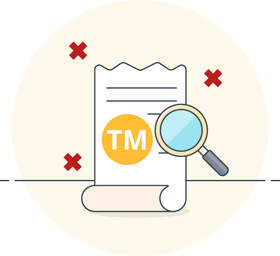Apart from that special formula you keep in the safe in the back, a trademark is one of your business’ most coveted assets. It’s what defines your business as uniquely yours in a sea of copycats.

It protects what you own and it can take many forms representing the intellectual property of your business and/or its products.
It may include a standalone or combination of the following:
- unique symbol
- logo
- word
- sound
- image
- number
- movement
- scent
- color
Once it’s registered, it gives you the right to use, license, or sell the trademark.
Some important business terms explained
Before we get into the nitty-gritty of trademarking, here is a handy glossary of terms relevant to the realm of trademarks.
|
Business name |
The name or title under which a person or entity conducts business (like Joe’s Chicken Shop). |
|
Trademark |
A trademark is a way of identifying a unique product or service. It's a form of brand protection that distinguishes your products or services from others. Using the same example as above, this might be the catchy jingle or eye-catching logo for Joe’s Chicken Shop. |
|
Copyright |
Copyright protects the expression of ideas and information in material form, like a recording or sound. However, it does not protect ideas and information. Back to Joe’s Chicken Shop, the owner may choose to obtain copyright for a film about the business. |
|
Patent |
A patent is a right that is granted for any device, substance, method, or process that is new or original. It is the right to commercially capitalize on the invention. While copyright is more about expression, patents are on the invention itself. For instance, Joe may choose to patent the recipe for the business’s salt mix. |
|
Domain name |
A domain name is a license to use a specific name online. The most common uses for domain names are website addresses used to advertise business products and services and/or email addresses. An example would be Joe’s website URL, www.joeschickenshop.com |

What does it mean to trademark your business name?
As noted earlier a business name is the name of the company itself.
A common misconception is that a trademark is the same as a company name or domain name. It is not.
When you have a trademark, you don’t have rights to the word or phrase in general, but you do have rights to how that word or phrase is used with reference to your business, its goods, or its services.
What are the main benefits of trademarks?
While you may spend some time and money in the process of trademarking your business, there are some benefits to getting it done.
- A trademark provides legal protection. When you register a trademark you own the exclusive rights to it. It allows you to take legal action to prevent others from using your intellectual property.
- Trademarks help guard against misuse. This includes potential counterfeiting and fraud.

Common trademark mistakes
According to Australian legal specialists Legal Vision there are common mistakes around trademarks.
These include:
Confusing your business name with trademark rights
Businesses operating in Australia need to apply for an Australia Business Number (ABN) and register a business name.
When a company is registered, it does not have automatic trademark rights.
Businesses seeking to trademark an aspect of their business will need to register for a trademark to protect their goods and services.
Forgetting to register the business or domain name
Once a trademark is registered, it does not extend protection to the business’s name or domain name.
If broader coverage is needed, the business can choose to register the trademark, the business name, and the domain name.
To ensure protection, the business owner needs to check the availability of all three early and register them as soon as possible. Because if someone else registers that domain name, it can be costly to buy it from them.
Making the trademark too descriptive
Choosing a business name is one of the most important decisions business owners can make.
Having a distinctive name is advantageous because it sets the business apart from others and makes the name more likely to be registered as a trademark.
The relevant Trademark Act requires a trademark to be distinctive enough to distinguish its goods and services from other businesses.
For example, a name like ‘Bondi Hair and Beauty’ tells the customers what the business does and where: hair and beauty in Bondi.
However, registering the same name for trademark purposes is likely too prescriptive as it would be unfair to prevent other salons from using the entire phrase ‘Bondi hair and beauty.’
Expecting a trademark covers exclusive rights everywhere
Another common misconception is that a trademark gives the owner the right to use the trademark everywhere.
The registered trademark gives the owner the right to use the trademark in relation to the goods or services under which they are registered. This is often specific to the industry it’s operating in.
For example, a grocery store will not be able to enforce its trademark against a company in the electronics industry.
Additionally, that right extends only within the country it’s currently operating.
So as a business owner you will need to assess what’s required in the country you want protection in.
What to do before you register a trademark
Before you register you’ll need to check the jurisdiction you’re operating in to assess you are eligible based on the criteria.
You should also run a trademark search by the relevant authority governing that jurisdiction.
|
Country |
Australia |
US |
|
Trademark info |
Businesses should first run a trademark search using IP Australia. A trademark’s life is ten years and can be renewed to maintain the trademark. |
In the US businesses can use the USPTO’s Trademark Electronic Search System to search existing trademarks. A trademark registration can be infinite so long as you continue to use the trademark in commerce and provide the USPTO with evidence it’s in use. |
|
Costs |
Fees vary and commence from AUD $150. The approximate costs are available on IP Australia. |
Costs will vary and depend on a number of factors such as the application filing form and number of classes of goods or services in the application. Approximate costs commence from USD$250. Further information is available on USPTO’s site. |
While you don’t need a lawyer to file the trademark on your behalf, there are additional benefits in drawing on the skills of a legal specialist. These include:
- A lawyer can help you prepare your application accurately
- You can receive appropriate legal advice and better understand the relevant Acts
- They can help with undertaking your trademark clearance search before you file

Trademarks can be tricky business
A few years ago multinational oil and gas company BP lost its fight against Australian grocery store Woolworths to use Pantone 348C green exclusively in its logo (the grocery retailer uses a similar color in its logo).
Note that to trademark a color a business needs to establish that color as being distinctive of a business’s goods and services. It needs to demonstrate the use of that color alone, as the trademark.
Some brands have successfully trademarked colors in the past. Among those include Tiffany & Co’s robin egg blue and Post-Its’ canary yellow for its sticky notes.
But when it comes to being granted exclusive use of a color for trademarking purposes, the weight is on the company to prove the color is widely associated with its brand.
In this case of BP, the Federal Court found that while the specific Pantone green color had been used as a predominant color, it was also used alongside yellow in its sunburst logo.
This meant the green color on its own was not sufficient to distinguish BP’s goods and services.
It’s important to consider that successful color trademarking does not allow ownership of that color, but the rights to use it exclusively for the business’s product category or industry it operates in.
When in doubt, seek help
So the point in all this? Trademarks can be complicated.
It’s important to ensure you know how a trademark can protect you and your business and what it may and may not cover.
If in doubt, consider seeking quality legal advice. This will inform the best course of action for you and your business.

